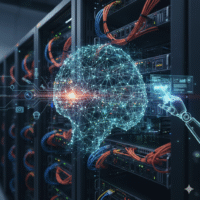The Role of Machine Learning in Cybersecurity: A Complete Guide
Published: 20 Jul 2025
We hear daily that cyberattacks get faster, smarter, and more unpredictable. Even though traditional cybersecurity tools are still useful, they often can’t keep up with how advanced modern threats are. Machine learning (ML) is a powerful new tool in this battle to keep our online spaces safe.
It is like a digital guardian that never sleeps at night, learns from every event it faces, and sees patterns that people can’t often see. Machine learning is changing the way we protect our digital infrastructure by finding malware in milliseconds, guessing how hackers will act toward our systems, and stopping spam and phishing scams before they get into our inboxes.
Machine learning is becoming a part of cybersecurity in many areas, including banks, email services, and business networks. But how does it work? What makes it work so well? And what problems do professionals face when they try to make it work? Let’s look at each of these clearly and simply.
Machine Learning in Cybersecurity
Machine learning enhances cybersecurity by infusing our previously fixed, set-rule-based systems with intelligence and flexibility. Old-style rule-based systems usually don’t work well when they face new or surprising situations.
Machine learning turns those models upside down. Now ML algorithms look at a lot of historical and real-time data to find strange behavior or patterns that could mean an attack.
These models can learn what “normal behavior” looks like and flag anything that looks different, so they don’t need a list of things to look for ahead of time. For example, if a user suddenly logs into a database at 5 a.m.
If a different place downloads some big files that it should not have downloaded, the system might send out an alert that something has happened. One of ML’s biggest strengths is that it can cut down on false positives.
Cybersecurity teams get a lot of alerts, and many of them are not often dangerous. ML filters out the noise and only brings real threats to people’s attention by figuring out which anomalies are important and which are not.
This lets analysts spend their time and energy on protecting against real threats instead of wasting time on useless things. ML is also a dynamic method. It changes as attackers do. Every new attack teaches the system something new about how threats work.
is ability to change is very important in a world where threats are always changing. Therefore, processing data in real time is another significant advantage, as machine learning systems can rapidly analyze incoming data streams, enabling security teams to respond immediately when a threat arises. This speed is very important in cybersecurity, where every second is more important.
Real World Applications of ML in Cybersecurity
Machine learning is not just a theory; it is already being used in many fields to keep data, systems, and users safe. Some of the most important uses are:
1. Malware and Ransomware Detection
Traditional antivirus programs used to work by scanning for signatures, “digital fingerprints of known viruses.” Now, the issue is that new malware continuously evolves, altering its appearance or concealing itself in ways that can easily avoid these traditional detection methods. That’s why machine learning is so useful.
Instead of relying on predefined signatures, ML analyzes a file’s behavior, like what it touches and where it sends data. Also, machine learning flags suspicious activities, even in the case of newly discovered malware. This renders it a potent safeguard against erratic and emerging threats.
2. Phishing and Email Security
Phishing emails get smarter every day, and scammers fool people by pretending to be genuine companies or using smart psychological tricks. However, now it is beneficial that computers can detect these fraudulent emails. These systems detect scams by analyzing the sender’s behavior, the words used, and your responses.
Email services like Gmail and Outlook are already using this smart technology to stop phishing, and they don’t just look for harmful links, but they also learn from spam reports, which helps them get better at stopping new tricks as time goes on.
3. Fraud Detection in Financial Systems
Banks and fintech companies use machine learning (ML) to find fake transactions as they happen. These systems keep track of how people usually spend money. If something strange happens, like a sudden big withdrawal or a lot of quick transactions in a row, the ML marks it as suspicious. Unlike old-fashioned detection’s strict rules, this smart approach changes with the times. Finally, this adaptive fraud detection method makes things safer and makes the customer experience easier over time.
4. Intrusion Detection in Networks
Machine learning helps security systems find hackers on their own. It keeps an eye on all the devices on a network and lets you know if something strange happens. Big machine learning is now being added to security systems like IDS so that they can automatically catch hackers.
These smart systems can monitor thousands of connected devices simultaneously and detect any unusual activity in them, such as when your office printer or a camera automatically connects with a suspicious foreign server; by this, your data can be leaked. Now, big companies rely heavily on this technology because their vast networks are too complex for individuals to monitor independently.
5. Predictive Threat Intelligence
Using machine learning to predict possible threats before they happen is probably the most futuristic use of predictive analytics. In cyber incidents around the world, threat reports, and how attackers behave, ML can help predict new attacks by looking at patterns and methods, and getting defenses ready ahead of time.
Challenges and Limitations of ML in Security
Machine learning is very exciting, but it can’t fix everything in cybersecurity. Several big problems we face while using ML in cybersecurity:
1. Adversarial Machine Learning
Cybercriminals are now using adversarial machine learning methods to trick AI systems by giving them wrong data that is hard for AI to understand. Like, they make small changes to a file that make the AI think it’s safe, while it is dangerous. This strategy is very risky nowadays because it uses AI’s learning methods against itself, which makes it less reliable for the future.
2. Data Quality and Quantity
Machine learning isn’t magic; it only works based on the data you give it. If you give a model old, messy, or one-sided data to work with, it will give you bad results, because you will get what you trained the AI on, right? But getting the best results is not so easy. For this, you need a lot of new and correct data, and also, there are strict rules about its use in some fields, like finance and healthcare. So, you have to keep checking the data even after you get it because what worked yesterday might not work today.
3. False Negatives
Machine learning may reduce false alarms, but it will still miss real threats (false negatives) in the security of the systems. In cybersecurity, missing even one detection can lead to many big problems. So we need to find the right balance to make sure that detections of threats are both quick and accurate.
4. Model Drift and Maintenance
ML models need to keep learning from new data, and if a model only knows the old information, it definitely won’t be able to see new threats over time. This condition is known as model drift. The AI models need regular updates to stay smart and useful over time. So these updates take time, skill, and more computer power.
5. The “Black Box” Problem in AI (Deep Learning)
Many AI systems, especially complicated ones like neural networks, give answers without saying how they got there.
Why is such information important?
- Security teams can’t tell if an alert is real or just a mistake.
- It’s hard to get people to trust AI when even experts don’t fully understand how it recognises them and whether they are correct or not.
But scientists are working to find the right solution, and it is still a big problem.
Future of AI-Powered Cybersecurity

1. Future of AI in Cybersecurity
In the future, AI will change cybersecurity by making systems stronger, smarter, faster, and more flexible over time. Here is what you can expect from AI in the future:
2. Instant Threat Response
AI will automatically stop attacks by isolating infected systems, stopping suspicious activities, or redirecting traffic. This way, the response time will go from hours to just seconds.
3. Stopping Social Engineering
AI will use advanced language analysis to find scams, fake identities, and emotional manipulation in emails, chats, and calls. This will help stop phishing and fraud.
4. Global Threat Sharing
AI will connect to databases of threats from around the world, which will help companies find new malware and ways to attack before they can do any damage to our companies.
5. Privacy-Safe AI
Federated learning and other new methods will let AI get better without sharing sensitive data, which is very important for fields like banking and healthcare.
6. AI vs AI Battles
Hackers will also use AI to make malware that learns and changes according to our designed AI systems. So, to stay protected, you need to keep improving and strengthening your defenses over time.
Conclusion
Machine learning has made cybersecurity smarter by letting it plan and act smartly instead of just reacting to threats to save our systems. Machine learning learns from the past and changes itself to fit the present threats; it is the best technique to fight against hard situations until now.
This lets us see and stop threats before they happen, but it’s not enough for all situations. But for this, it needs to be carefully put into action, watched all the time, and secured by those who know deeply about it. It works because it maintains a good balance between speed and strategy, like both complexity and clarity, and automation and human insight.
As cyberthreats change over time, our defences also need to get smarter against them. So, we are getting closer to a future with machine learning where our digital spaces are protected by such AI automated systems that learn new things and save our systems from cyber threats every day.
FAQs
Machine learning makes cybersecurity better by finding threats early, adjusting to new attacks, and stopping hackers and viruses that haven’t been seen before from doing damage.
Machine learning is like a smart brain for security tools. It can find strange behavior, phishing emails, and viruses, and it lets you respond quickly and keep learning to keep your data safe.
Artificial intelligence is making the internet safer by spotting threats right away, fixing problems quickly, learning how hackers work, and stopping fake content.

- Be Respectful
- Stay Relevant
- Stay Positive
- True Feedback
- Encourage Discussion
- Avoid Spamming
- No Fake News
- Don't Copy-Paste
- No Personal Attacks

- Be Respectful
- Stay Relevant
- Stay Positive
- True Feedback
- Encourage Discussion
- Avoid Spamming
- No Fake News
- Don't Copy-Paste
- No Personal Attacks





